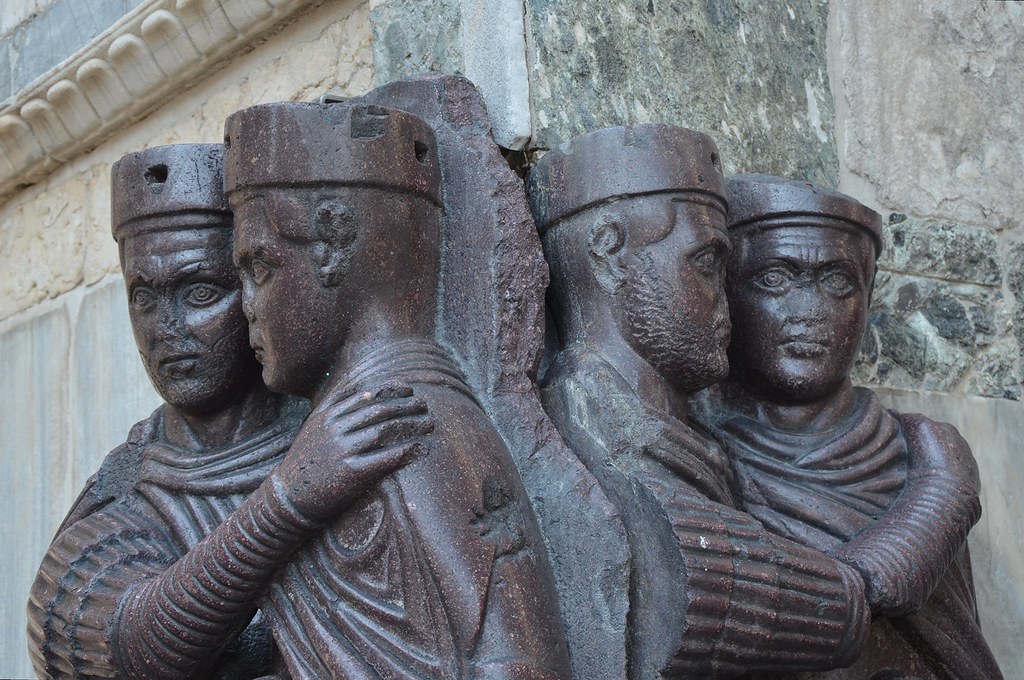We’re Still Making Diocletian’s Mistakes
Some of the most telling moments in history are when we look back and see people in a vastly different world behaving exactly as people do today. From 286 to 305 Diocletian, one of Rome’s most powerful and consequential emperors, tried to fix the political and economic systems which he inherited and were teetering on the brink of collapse. In doing so, he made mistakes remarkably similar to those made by people in government today.
The world Diocletian inherited was staggering out of the Crisis of the Third Century, a 50-year period that saw 26 claimants to the imperial robes, most of whom seemed guided by nothing more than personal greed and ambition. Relatively speaking, Diocletian brought stability and good intentions to the Roman state and helped it persist for another 150 years.
But virtually all of Diocletian’s individual reforms sought a stronger imperial state that exploded in both bureaucracy and godlike pageantry in an attempt to engineer prosperity from the top down. The astonishing part is that after more than 1,700 years, after the development of economics as a field of study, and under the auspices of liberal democracy, governments today proceed with largely the same instincts.
Is Four Greater Than One?
The man who would become known as Gaius Aurelius Valerius Diocletianus Augustus was born in present-day Croatia in the year 244. He first came to power as many emperors did, with an army under his command proclaiming him as such, and ultimately defeating other military rivals.
Diocletian realized that his vast empire was too large and complex to be ruled by a single man. This insight about the limits of top-down control may have been forward-thinking, but his solution shows how deeply important the elites of his time viewed a strong centralized state. By 293, Diocletian had fully formed the tetrarchy, where two junior and two senior emperors bound by a set of marriages would each rule a quarter of the empire.
This limited sharing of power at the top only enhanced the imperial state’s ability to control Roman society. Historian Warren Treadgold estimates that Diocletian doubled the number of government bureaucrats from 15,000 to 30,000. He doubled the number of provinces in the empire (giving rise to the dioceses around which the Catholic Church still organizes today). In addition, Diocletian dropped longstanding pretenses of cooperation between the emperor and other civil and military institutions, and presented himself and co-emperors as godlike during highly formalized ceremonies.
These changes were highly successful from the perspective of the Roman state’s continued existence and dominance. And unlike famous tyrants like Caligula and Nero, Diocletian’s wielding of power seems more paternalistic than predatory. However, just like the most well-intentioned large-scale state interventions today, Diocletian’s reforms ultimately showed the futility of attempting to create a healthy society by edict.
We see the assumption especially among today’s political left that a more powerful central government staffed with the right people will heal society’s ills. But putting a society under increasing central control magnifies the damage done by mistakes from one or a small group of people. Though likely spearheaded by co-emperor Galerius, the Diocletianic Persecution of Christians was the largest and last of such organized pogroms. Concentrated power can go from benevolent to catastrophic very quickly.
The tetrarchy was also supposed to bring an end to the corrosive wars of succession that plagued Rome during the Crisis of the Third Century. But the state apparatus carefully put in place by Diocletian and his associates likely made imperial power even more attractive. Constantine, the son of co-emperor Constantius, was snubbed in a handoff of power within the tetrarchy. That, of course, led to the end of both the tetrarchy and large-scale Christian persecution in the empire.
Economist in Chief
Stephen Guerra, host of the History of the Papacy podcast, reminds us that Diocletian’s worldview was likely molded by his time as a general. Applying that logic to Rome’s economy, he tried to order people and merchants to make the economic decisions he thought best. The analogy is a telling one. The entire structure of a military, including its suppression of individual freedom, is geared toward making large groups execute orders from the top down. Imposing such a structure on an economy many times larger, more complex, and more central to the everyday lives of millions is utterly impossible.
It’s perplexing, then, that if one strips away the military despotism of Diocletian’s world, the economic measures he took parallel our debates today. Writing in 2012, my colleague Peter C. Earle gave a helpful description of those policies and their similarities to the Keynesian proposals of Paul Krugman.
On the fiscal side, Diocletian’s policies could fairly be labeled as tax-and-spend. He unleashed the imperial state’s torrential new bureaucracy on finding out just who everyone in the empire was (through a census) and calculating exactly how much they owed the government. Diocletian raised rates and closed loopholes: citizens of the Italian peninsula lost their centuries-old tax exemption. He was not shy about putting these funds to use: he was a prodigious builder and conqueror and greatly expanded public aid programs.
This fiscal approach made solving the runaway inflation Diocletian inherited impossible. The empire’s coins had been debased to the point of near worthlessness during the Crisis of the Third Century, as the endless stream of imperial usurpers needed ever more currency to buy the support of armies.
Diocletian began minting new coins with higher precious-metal content funded in part by confiscating metal jewelry from citizens, a move that wouldn’t have been out of place in the 20th century. This new currency kept the state and military going but did little else. The urban poor could never get their hands on the new, more stable currency. Much of it instead went right back into the state’s expansion, with historians going so far as to suggest that the very system to assess and collect taxes demanded a significant portion of the tax revenue:
He … created so many boards, commissions, and bureaus that every Roman with any pretensions to political pull had a government job, while his less fortunate fellow-citizens were fast being taxed to death for the support of a benevolent bureaucracy.
Still battling inflation, Diocletian went into full commander mode: if merchants kept raising prices, impose price ceilings by the sword. The Edict on Maximum Prices, published in 301, attempted to set price ceilings for over 900 goods and wages for 130 occupations. At first the edict closed businesses, caused shortages, and sparked unrest. It was ultimately mostly ignored.
Diocletian’s only action that isn’t still a part of our political and economic debate today is the wide menu of price controls, and even those would have neatly fit in the five-year plans of some states less than a century ago. Knowing the full consequences of Diocletian’s reforms is difficult, since that snub of Constantius’ son quickly led to more civil war, the retaking of the empire by one man, a massive shift in the balance of religious power, and a new imperial capital.
It’s possible that without Diocletian’s reforms, Constantine would not have had an empire worth conquering and converting. But cast in terms of the economic well-being of most of the empire’s citizens, Diocletian’s policies collided with the limits of top-down control again and again.
Battling History
What to make of the fact that Diocletian’s policies resonate so deeply in our debate 1,700 years later? Earle notes that Diocletian had essentially no economic theory at his disposal. On the contrary:
With 2,000 years of recorded history between the 3rd-century calamities of the Roman Empire and the present day — plus a handful of recent, well-documented economic crackups perusable amid a wide range of discredited economic theories — what excuses can Krugman offer?
Many will point to the obvious political, economic, technological, and cultural differences between Diocletian’s time and our own. And in a sense they’re right. The fact that an interventionist state funded by high taxation and coinage didn’t work in Diocletian’s time does not on its own provide an open-and-shut case that it wouldn’t or doesn’t in our own.
My own takeaway is that the parallels speak to parts of human nature older and deeper than economic theory — the sense that results are best achieved through direct or top-down control. All the economic theory in the world espousing markets, competition, and individual choice can only partially cure us of this illusion.
History has shown that the instinct to command an economy like a general presents itself across many people in many ways. Diocletian may have greatly strengthened the Roman state, but that extra strength appears not to have dented poverty, inflation, or civil war. Today the instinct to increase state power to achieve desired outcomes is thriving on both sides of the aisle. The best and only way to counter that tendency is bottom-up thinking based on the capacity of people to manage their lives without imposition from the top. .
Epilogue
Whether by design of his tetrarchic system or due to illness, in 305 Diocletian became one of Rome’s only emperors to abdicate and retire. He settled in his massive palace whose ruins are still prominent in the modern-day city of Split, Croatia to do what any former god-like ruler would do: he raised cabbages and other vegetables in his garden. As the imperial system he left behind began to teeter, an emissary appeared asking Diocletian to return to power and restore stability. Diocletian’s legendary response was probably written by later historians, but rings through the ages as one of history’s great quotes:
If you could show the cabbage I planted with my own hands to your emperor, he definitely wouldn’t dare suggest I replace the peace and happiness of this place with the storms of a never-satisfied greed.
We can’t pretend to know what truly made historical figures from millennia past tick. But I like to think that Diocletian’s peace and happiness came from finally finding something he could control with his own hands.
History podcasting is making rigorous, well sourced, and entertaining storytelling available to anyone. I’m indebted to Mike Duncan’s History of Rome and Stephen Guerra’s History of the Papacy podcasts for much of the inspiration to write this piece.











